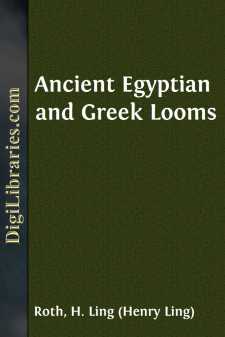Categories
- Antiques & Collectibles 13
- Architecture 36
- Art 48
- Bibles 22
- Biography & Autobiography 813
- Body, Mind & Spirit 142
- Business & Economics 28
- Children's Books 17
- Children's Fiction 14
- Computers 4
- Cooking 94
- Crafts & Hobbies 4
- Drama 346
- Education 46
- Family & Relationships 57
- Fiction 11829
- Games 19
- Gardening 17
- Health & Fitness 34
- History 1377
- House & Home 1
- Humor 147
- Juvenile Fiction 1873
- Juvenile Nonfiction 202
- Language Arts & Disciplines 88
- Law 16
- Literary Collections 686
- Literary Criticism 179
- Mathematics 13
- Medical 41
- Music 40
- Nature 179
- Non-Classifiable 1768
- Performing Arts 7
- Periodicals 1453
- Philosophy 64
- Photography 2
- Poetry 896
- Political Science 203
- Psychology 42
- Reference 154
- Religion 513
- Science 126
- Self-Help 84
- Social Science 81
- Sports & Recreation 34
- Study Aids 3
- Technology & Engineering 59
- Transportation 23
- Travel 463
- True Crime 29
Ancient Egyptian and Greek Looms
Categories:
Description:
Excerpt
I. Egyptian Looms.
HORIZONTAL LOOMS.
IN the tomb of Chnem-hotep, at Beni Hasan, there is a wall painting of a horizontal loom with two weavers, women, squatting on either side, and at the right in the background is drawn the figure of the taskmaster. There are also figures represented in the act of spinning, etc. For the present we are concerned with the weaving only.
Fig. 1.—Horizontal Loom, Tomb of Chnem-hotep, from the illustration in Cailliaud’s Recherches, etc. Same size as published.
Of this illustration, there appear to be six reproductions. We have first of all, , that of Fred. Cailliaud (Recherches sur les Arts et Métiers, etc., Paris, 1831) with illustrations of drawings made by himself in the years 1819 to 1822. His publication was followed by , that of Sir J. G. Wilkinson (Manners and Customs, etc., London, 1837). Mr. John Murray, whose house has published Wilkinson’s work from the first edition to the last, informs me that a few of the drawings were made by George Scharf, afterwards Sir George Scharf, Keeper of the National Portrait Gallery, but that most of them seem to have been made by Joseph Bonomi, the well known Egyptologist. Wilkinson’s woodcut, although clearly and neatly done, is on a very small scale; nevertheless it admits of a fair comparison with those reproduced on a larger scale.
Figs. 1 & 3. Weaving.Fig. 4. Male Overseer.Fig. 2. Loom.”5. Hackling.”3. Putting in the woof, but not by a shuttle thrown with the hand.”6. Twisting the double threads for the warp.aWeaving.bChief of Loom.cFacing.dPulling out.Fig. 2.—Horizontal Loom, Tomb of Chnem-hotep, from Sir J. G. Wilkinson’s Manners and Customs, London, John Murray, 1878, Vol. I., p. 317. Same size as published.
Fig. 3.—Horizontal Loom, Tomb of Chnem-hotep, from the illustration in Rosellini’s Monumenti (Monumenti Civili), Plate XLI. Reduced one-fifth lineal of size published.
Fig. 4.—Horizontal Loom, Tomb of Chnem-hotep, from Lepsius’ Denkmäler. Same size as published.
Fig. 5.—Horizontal Loom, Tomb of Chnem-hotep, from Prof. Percy Newberry’s Beni Hasan, I. Plate 29. Same size as published.
After him, , N. F. J. B. Rosellini began the publication of his great work (I Monumenti dell’ Egitto, Pisa, 1832-1844). The similarity between the comparatively few drawings published by Cailliaud and the very large number published by Rosellini is very great. It is of course quite possible Rosellini may have made use of some of Cailliaud’s drawings. Five years after Rosellini’s publication came that of C. R. Lepsius (Denkmäler, Leipzig, 1849), , his drawings having been made in the years 1842 to 1845. Since the time of Lepsius until quite recent years I can trace no further copying until we get the illustration, , in Prof. Percy Newberry’s Beni Hasan, London, 1910. In this work the reproduction is about one twentieth of the original, or about three fifths of the size of that of Wilkinson, and unfortunately so crude as not to be available for our present purpose. Lastly we have the reproduction,


